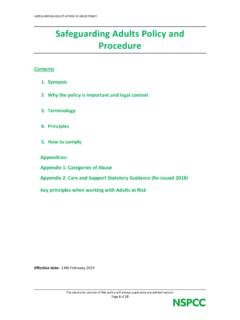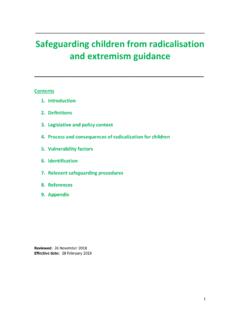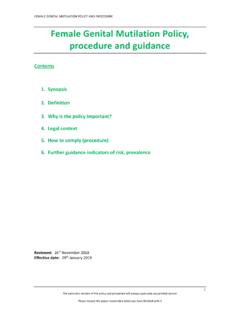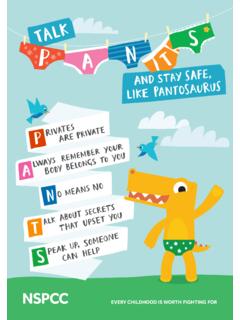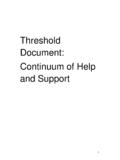Transcription of Procedure for managing safeguarding allegations - NSPCC
1 FLOWCHART F PUBLIC Procedure for managing safeguarding allegations against staff and volunteers Contents 1. Introduction 2. Roles and responsibilities 3. What is a safeguarding allegation? 4. What to do if an allegation is made 5. Initial considerations about managing a safeguarding allegation 6. Action following initial consideration 7. allegations against a CEO or Trustee 8. Suspension 9. Action following the conclusion of the external investigative process 10. Action in respect of unfounded or malicious allegations 11. Learning lessons Appendices 12. adults at risk 13. managing allegations against staff process flowchart 14. How might a safeguarding allegation come to light?
2 15. Support 16. Recording and record keeping 17. Referral for consideration to bar and/or professional de-registration 18. managing allegations against interns, secondees, agency staff, students, trustees, contractors and sole traders 19. Resignation and settlement agreements 20. Referral to the Charity Commission 21. Further information Effective Date: Revised 3 July 2018 Approved by: Executive Board PUBLIC 2 1. Introduction These procedures apply to all staff and volunteers, regardless of position or role within the agency The aim of these procedures is: To ensure that children and adults at risk are protected and supported following an allegation that they may have been abused by an adult working for or on behalf of the NSPCC To ensure that there is a fair, consistent and robust response to any safeguarding allegation made, so that any risk posed to other children or adults at risk by an abusive individual is managed effectively To ensure that an appropriate level of investigation into concerns or allegations takes place when the allegation is recent.
3 Or at any time the person in question has been employed or volunteered with the NSPCC To ensure that the NSPCC continues to fulfil its responsibilities towards members of staff, or volunteers who may be subject to such investigations To ensure NSPCC acts in accordance with legislation and guidance and the requirements of the Charity Commission Please note: this Procedure is separate and in addition to the process for immediate (same day) reporting of serious incident to the Chief Executive. The Chief Executive expects to receive on the same day information that relates to: In Children s Services a death or serious abuse or neglect in an open or recently closed case In National Services a death or serious abuse or neglect in a contemporaneous or recent telephone or online contact and any Death or serious abuse or neglect likely to trigger a Child safeguarding Case Review or equivalent, and/or likely to trigger media interest (imminently)
4 Obvious or apparent NSPCC /Childline serious systems failure recording system, or serious performance or conduct breach Death or serious incident that is very distressing to the practitioners/manager and to whom the Chief Executive might offer a word of support This information can be brief rather than a comprehensive report, with further information to follow if and as necessary, making a judgement about what needs to be shared. Same day alerts are the priority. The Chief Executive will then make a timely alert to all trustees. 2. Roles and responsibilities In the NSPCC , the responsibility for overseeing safeguarding allegations and appointing an investigating manager lies with the Head of safeguarding Unit (SU).
5 If they are unavailable the Director of Children Services will nominate another senior manager to undertake this role. If the Head of safeguarding Unit decides that independence is necessary to undertake an investigation, an independent person, external to the NSPCC will be identified by the Head of safeguarding Unit to carry this out. The Investigating Manager will be a person not directly involved in the allegation and someone who has completed the training on this Procedure . Further written guidance on the role of the investigating manager and that of line management will be provided. PUBLIC 3 3. What is a safeguarding allegation? Where it is alleged that any person working for or volunteering with the NSPCC has: Behaved in a way that has harmed a child, may have harmed a child, or might lead to a child being harmed Possibly committed or is planning to commit a criminal offence against a child or related to a child Behaved towards a child, children or adult at risk in a way that indicates s/he is or would be unsuitable to work with children Behaved in a way that has harmed, or may have harmed, an adult at risk This applies if the allegation is about a current incident or has occurred historically A child is a person up to the age of 18 years (16 years in Scotland).
6 The allegation may concern one or more children. The allegation can be about any child/adult at risk, for example a child/adult at risk: In receipt of an NSPCC service Involved in a fundraising or participation activity Not known to the NSPCC That a member of staff or volunteer has contact within their community/home life Is the son or daughter or family member of the employee or volunteer The allegation may: Not directly identify a known child victim. For example, if a staff member or volunteer is accessing abusive images of children online or using the internet to groom children with the intent to harm in future Be about any type of abuse physical, emotional, sexual or neglect Concern a breach of the NSPCC s safeguarding code of conduct and Policy on appropriate professional conduct Relate to NSPCC staff and volunteers who have behaved in a way that may have harmed an adult at risk (see appendix 12 for further information on types of abuse)
7 allegations of abuse that come to the NSPCC s attention more than twelve months prior to the initial allegation being made are regarded as non-recent abuse, also known as historic abuse Non-recent abuse allegations against employees or volunteers will be managed through the Non Recent Historical Abuse Policy (February 2016). Following a strategy meeting it may be necessary for a referral to Operation Hydrant to be made Refer to Appendix 2 for further information on how a safeguarding allegation may arise Also consider: The importance of referring the allegation onward, the timescales and who to involve Understand your responsibilities and limitations for each referral process Remember the 4 R s.
8 - Recognise concerns that a child is being harmed or might be at risk of harm- Respond appropriately to a child who is telling you what is happening to him or her- Refer the concerns, if appropriate, to the NSPCC helpline, police or children s social care or (in Scotland) the Children s Reporter PUBLIC 4 - Record the concerns appropriately and any subsequent action taken; no delay in passing on concerns. Timescales are in place to ensure that matters are resolved in a timely way but these are the maximum allowed and nothing should prevent a speedy response if this is required There may be a need for resolution and escalation the NSPCC has a responsibility to ensure that appropriate protective action is taken by the police or children s social care and, if not, to escalate the concern to establish the right protective action is taken to ensure the child is safe.
9 4. What to do if an allegation is made If a child or adult at risk, is at risk of immediate harm or needs emergency medical attention, the emergency services must be contacted and the parents/carers informed that immediate steps are being taken to get help. If the allegation does not relate to an NSPCC employee or volunteer, all actions taken should follow the What to Do If You Have Concerns about a Child or The safeguarding adults at Risk Policy and Procedure . The person who receives a safeguarding allegation must make a note of the basic details of the allegation, to include the: Name of the individual who the allegation is about and any other identifying information, including location Name of any children/adult at risk involved Date and time of the allegation arising Name and contact details of the person making the allegation Key information about the nature of the safeguarding allegation The person should then inform their line manager in the first instance and agree next steps to safeguard a child/ren or adult at risk.
10 If the concern is about the line manager then the person should inform the second line manager. Alternatively, if the person feels unable to do this, they can seek advice and guidance from the helpline duty manager. The line manager, helpline duty manager or supervisor must complete the allegation log form and pass on the information about the allegations within 24 hours to the Head of safeguarding Unit. If the allegation involves a specifically named child or adult at risk, the Head of safeguarding Unit will ensure a search of all NSPCC records is completed, to ascertain whether any records need to be secured or locked down or any equipment removed from the individual.
